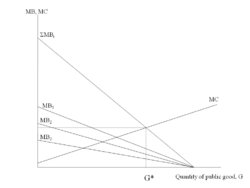Samuelson condition
Topic: Finance
 From HandWiki - Reading time: 2 min
From HandWiki - Reading time: 2 min
The Samuelson condition, due to Paul Samuelson,[1] in the theory of Public Economics, is a condition for optimal provision of public goods. For an economy with n consumers the conditions is:
- [math]\displaystyle{ \sum_{i=1}^n \text{MRS}_i = \text{MRT} }[/math]
MRSi is individual i's marginal rate of substitution and MRT is the economy's marginal rate of transformation between the public good and an arbitrarily chosen private good. Note that while the marginal rates of substitution are indexed by individuals, the marginal rate of transformation is not; it is an economy wide rate.
If the private good is a numeraire good then the Samuelson condition can be re-written as:
- [math]\displaystyle{ \sum_{i=1}^n \text{MB}_i = \text{MC} }[/math]
where [math]\displaystyle{ \text{MB}_i }[/math] is the marginal benefit to each person of consuming one more unit of the public good, and [math]\displaystyle{ \text{MC} }[/math] is the marginal cost of providing that good. In other words, the public good should be provided as long as the overall benefits to consumers from that good are at least as great as the cost of providing it (public good]]s are non-rival, so can be enjoyed by many consumers simultaneously).
When written this way, the Samuelson condition has a simple graphical interpretation. Each individual consumer's marginal benefit, [math]\displaystyle{ \text{MB}_i }[/math], represents his or her demand for the public good, or willingness to pay. The sum of the marginal benefits represent the aggregate willingness to pay or aggregate demand. The marginal cost is, under competitive market conditions, the supply for public goods. Hence the Samuelson condition can be thought of as a generalization of supply and demand concepts from private to public goods.
See also
- Lindahl equilibrium
References
- ↑ Samuelson, Paul A. (1954), The Theory of Public Expenditure, in: Review of Economics and Statistics 36, pp. 386–389.
- Brümmerhoff, Dieter (2001), Finanzwissenschaft, München u.a.O.
 |
 KSF
KSF
